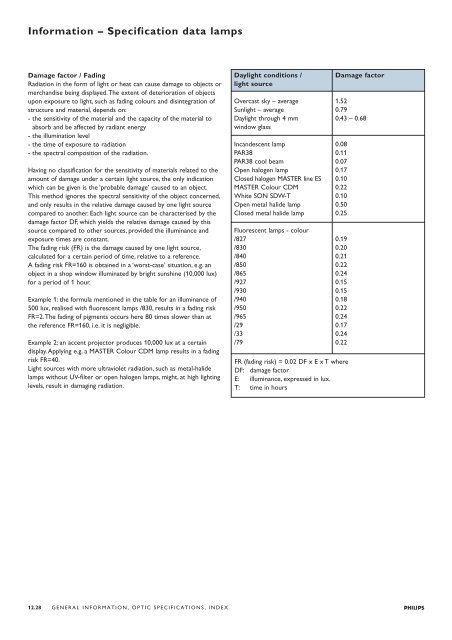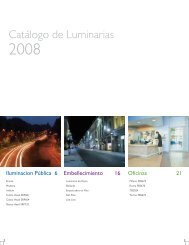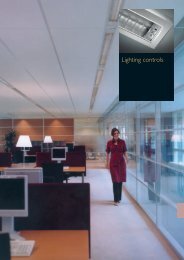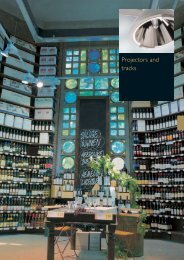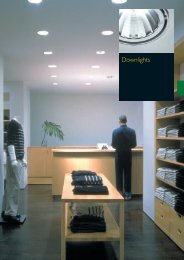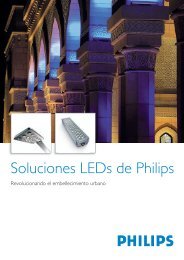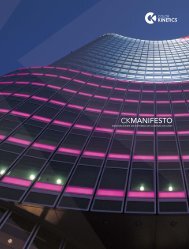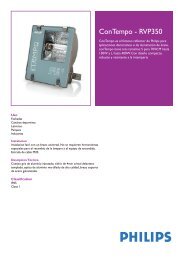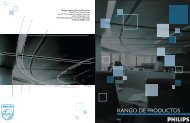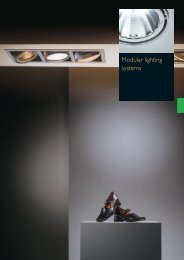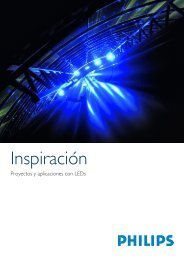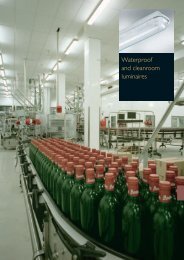General information, optic specifications, index
General information, optic specifications, index
General information, optic specifications, index
Create successful ePaper yourself
Turn your PDF publications into a flip-book with our unique Google optimized e-Paper software.
L966D967_SRC.QXD 11-03-2004 08:25 Pagina 12.28<br />
Information – Specification data lamps<br />
Damage factor / Fading<br />
Radiation in the form of light or heat can cause damage to objects or<br />
merchandise being displayed.The extent of deterioration of objects<br />
upon exposure to light, such as fading colours and disintegration of<br />
structure and material, depends on:<br />
- the sensitivity of the material and the capacity of the material to<br />
absorb and be affected by radiant energy<br />
- the illumination level<br />
- the time of exposure to radiation<br />
- the spectral composition of the radiation.<br />
Having no classification for the sensitivity of materials related to the<br />
amount of damage under a certain light source, the only indication<br />
which can be given is the ‘probable damage’ caused to an object.<br />
This method ignores the spectral sensitivity of the object concerned,<br />
and only results in the relative damage caused by one light source<br />
compared to another. Each light source can be characterised by the<br />
damage factor DF, which yields the relative damage caused by this<br />
source compared to other sources, provided the illuminance and<br />
exposure times are constant.<br />
The fading risk (FR) is the damage caused by one light source,<br />
calculated for a certain period of time, relative to a reference.<br />
A fading risk FR=160 is obtained in a ‘worst-case’ situation, e.g. an<br />
object in a shop window illuminated by bright sunshine (10,000 lux)<br />
for a period of 1 hour.<br />
Example 1: the formula mentioned in the table for an illuminance of<br />
500 lux, realised with fluorescent lamps /830, results in a fading risk<br />
FR=2.The fading of pigments occurs here 80 times slower than at<br />
the reference FR=160, i.e. it is negligible.<br />
Example 2: an accent projector produces 10,000 lux at a certain<br />
display.Applying e.g. a MASTER Colour CDM lamp results in a fading<br />
risk FR=40.<br />
Light sources with more ultraviolet radiation, such as metal-halide<br />
lamps without UV-filter or open halogen lamps, might, at high lighting<br />
levels, result in damaging radiation.<br />
12.28 GENERAL INFORMATION, OPTIC SPECIFICATIONS, INDEX<br />
Daylight conditions /<br />
light source<br />
Overcast sky – average<br />
Sunlight – average<br />
Daylight through 4 mm<br />
window glass<br />
Incandescent lamp<br />
PAR38<br />
PAR38 cool beam<br />
Open halogen lamp<br />
Closed halogen MASTER line ES<br />
MASTER Colour CDM<br />
White SON SDW-T<br />
Open metal halide lamp<br />
Closed metal halide lamp<br />
Fluorescent lamps - colour<br />
/827<br />
/830<br />
/840<br />
/850<br />
/865<br />
/927<br />
/930<br />
/940<br />
/950<br />
/965<br />
/29<br />
/33<br />
/79<br />
Damage factor<br />
1.52<br />
0.79<br />
0.43 – 0.68<br />
0.08<br />
0.11<br />
0.07<br />
0.17<br />
0.10<br />
0.22<br />
0.10<br />
0.50<br />
0.25<br />
0.19<br />
0.20<br />
0.21<br />
0.22<br />
0.24<br />
0.15<br />
0.15<br />
0.18<br />
0.22<br />
0.24<br />
0.17<br />
0.24<br />
0.22<br />
FR (fading risk) = 0.02 DF x E x T where<br />
DF: damage factor<br />
E: illuminance, expressed in lux.<br />
T: time in hours


